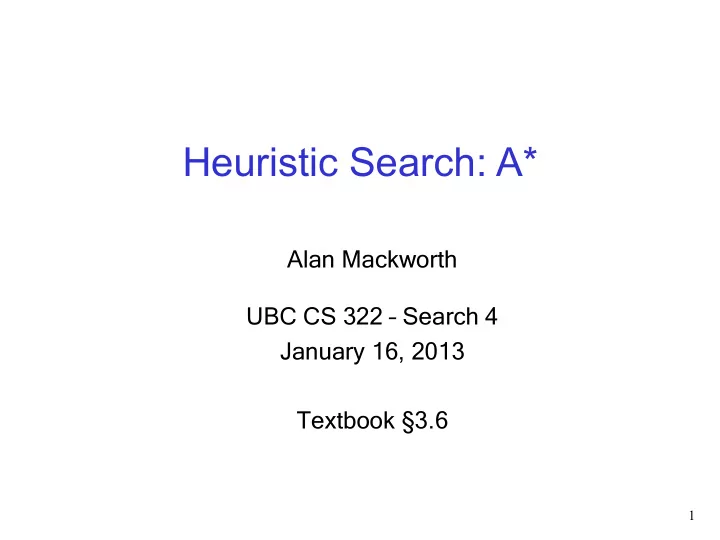

Heuristic Search: A* Alan Mackworth UBC CS 322 – Search 4 January 16, 2013 Textbook §3.6 1
Lecture Overview • Recap • Search heuristics: admissibility and examples • Recap of BestFS • Heuristic search: A* 2
Example for search with costs: finding routes 3
Lowest-Cost First Search (LCFS) • Expand the path with the lowest cost – Generalization of Breadth-First Search – Implemented as priority queue of cost values • Only complete for strictly positive arc costs - Otherwise: a cycle with zero cost <= 0 could be followed forever • Only optimal for non-negative arc costs - Otherwise: a path that initially looks high-cost could end up getting a `refund’ O ( b m ) • Time and space complexity: - E.g., uniform arc costs: identical to Breadth-First Search Slide 4
Search heuristics Def.: A search heuristic h(n) is an estimate of the cost of the optimal (cheapest) path from node n to a goal node. Estimate: h(n1) n1 Estimate: h(n2) n2 n3 Estimate: h(n3) Slide 5 5
Lecture Overview • Recap • Search heuristics: admissibility and examples • Recap of BestFS • Heuristic search: A* 6
Last lecture’s example: finding routes • What could we use as h(n)? E.g., the straight-line distance between source and goal node 7
Admissibility of a heuristic Def.: Let c(n) denote the cost of the optimal path from node n to any goal node. A search heuristic h(n) is called admissible if h(n) ≤ c(n) for all nodes n, i.e. if for all nodes it is an underestimate of the cost to any goal. • Example: is the straight-line distance admissible? YES NO - Yes! The shortest distance between two points is a line. 8
Admissibility of a heuristic Def.: Let c(n) denote the cost of the optimal path from node n to any goal node. A search heuristic h(n) is called admissible if h(n) ≤ c(n) for all nodes n, i.e. if for all nodes it is an underestimate of the cost to any goal. Another example: the goal is Urzizeni (red box), but all we know is the straight-line distances to Bucharest (green box) • Possible h(n) = sld(n, Bucharest) + cost(Bucharest, Urzineni) • Admissible? YES NO 9
Example 2: grid world • Search problem: robot has to find a route from start to goal location G on a grid with obstacles • Actions: move up, down, left, right from tile to tile • Cost : number of moves • Possible h(n)? - Manhattan distance (L 1 distance) to the goal G: sum of the (absolute) difference of their coordinates - Admissible? YES NO 4 3 G 2 1 1 2 3 4 5 6 10
Example 3: Eight Puzzle • One possible h(n): Number of Misplaced Tiles YES NO • Is this heuristic admissible? 11
Example 3: Eight Puzzle • Another possible h(n): Sum of number of moves between each tile's current position and its goal position YES NO • Is this heuristic admissible? 12
How to Construct an Admissible Heuristic • Identify relaxed version of the problem: - where one or more constraints have been dropped - problem with fewer restrictions on the actions • Grid world: the agent can move through walls • Driver: the agent can move straight • 8 puzzle: - “ number of misplaced tiles ” : tiles can move everywhere and occupy same spot as others - “ sum of moves between current and goal position ” : tiles can occupy same spot as others • Why does this lead to an admissible heuristic? - The problem only gets easier! 13
Lecture Overview • Recap • Search heuristics: admissibility and examples • Recap of BestFS • Heuristic search: A* 14
A* Search • A* search takes into account both - the cost of the path to a node c(p) - the heuristic value of that path h(p). • Let f(p) = c(p) + h(p). - f(p) is an estimate of the cost of a path from the start to a goal via p. c(p) h(p) f(p) 15
A* Search Algorithm • A* combines elements of which two search algorithms? Least cost first Best-first Breadth-first Depth-first • It treats the frontier as a priority queue ordered by f(n) • It always chooses the path on the frontier with the lowest estimated distance from the start to a goal node constrained to go via that path. • Let’s see it in action: 16
A* in Infinite Mario Bros http://www.youtube.com/watch?v=0s3d1LfjWCI http://www.youtube.com/watch?v=DlkMs4ZHHr8 17
Analysis of A* Def.: The time complexity of a search algorithm is the worst-case amount of time it will take to run, expressed in terms of - maximum path length m - maximum forward branching factor b . • What is time complexity of A* in terms of m and b ? O ( b m ) O(bm) O(m b ) O(b+m) • E.g., uniform costs and constant heuristic h(n) = 0 - Behaves exactly like BFS 18
A* completeness and optimality • A* is complete (finds a solution, if one exists) and optimal (finds the optimal path to a goal) if: - the branching factor is finite - arc costs are > >0 ε - h(n) is admissible -> an underestimate of the length of the shortest path from n to a goal node. • This property of A* is called admissibility of A* 19
Learning Goals for today’s class • Construct heuristic functions for specific search problems Define/read/write/trace/debug different search algorithms - With/without cost - Informed/Uninformed • Formally prove A* optimality (continued next class) 20
Recommend
More recommend